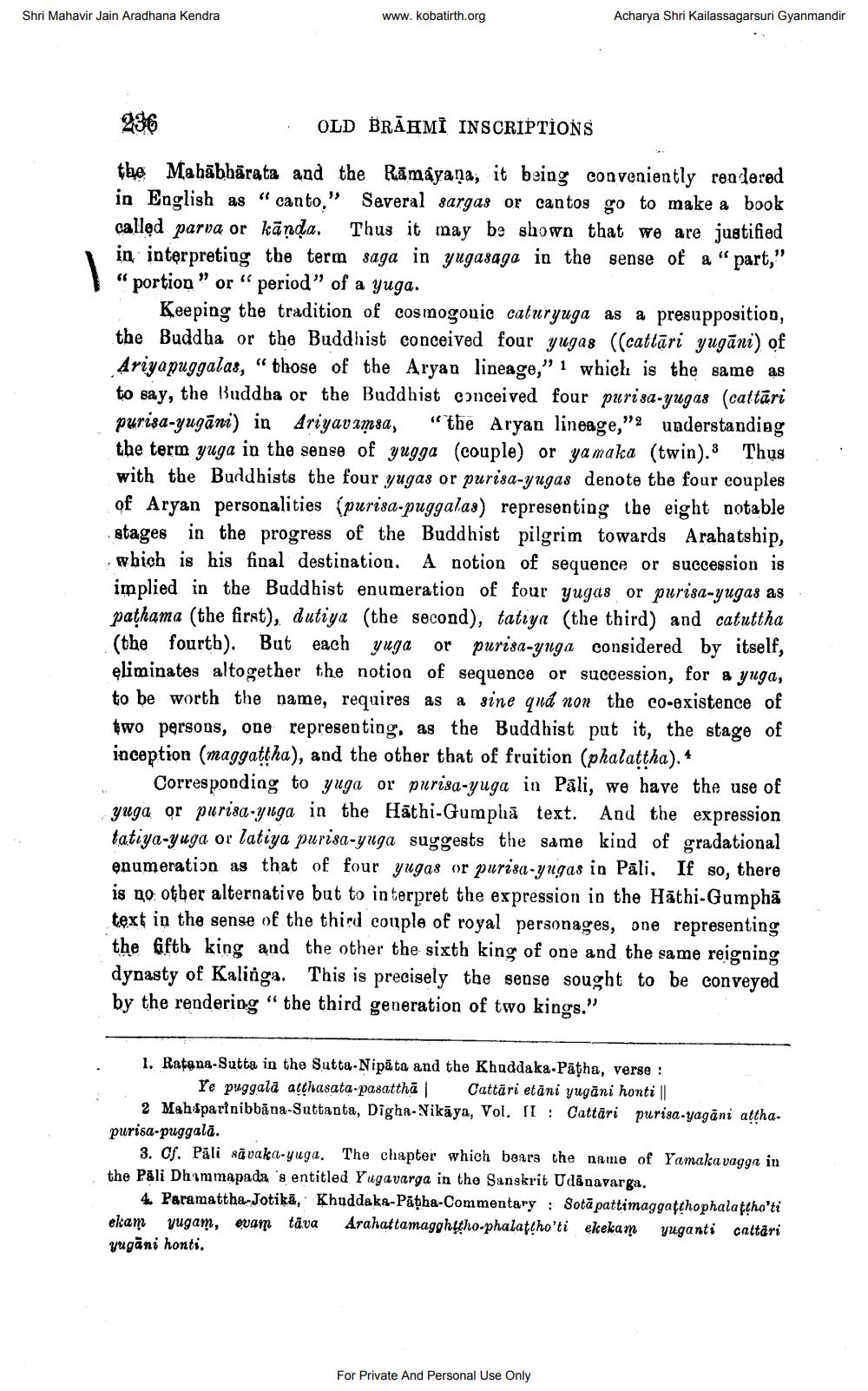________________
Shri Mahavir Jain Aradhana Kendra
www.kobatirth.org
Acharya Shri Kailassagarsuri Gyanmandir
OLD BRAHMİ INSCRIPTIONS
the Mahābhārata and the Rāmāyaṇa, it being conveniently rendered in English as “canto." Several sargas or cantos go to make a book called parva or kānda. Thus it may be shown that we are justified in interpreting the term saga in yugasaga in the sense of a "part," “portion " or "period” of a yuga.
Keeping the tradition of cosmogonic caturyuga as a presupposition, the Buddha or the Buddhist conceived four yugas ((cattāri yugāni) of Ariyapuggalas, “those of the Aryan lineage," i which is the same as to say, the Buddha or the Buddhist conceived four purisa-yugas (cattāri purisa-yugāni) in Ariyavınsa, "the Aryan lineage,"2 understanding the term yuga in the sense of yugga (couple) or yamaka (twin).3 Thus with the Buddhists the four yugas or purisa-yugas denote the four couples of Aryan personalities (purisa-puggalas) representing the eight notable stages in the progress of the Buddhist pilgrim towards Arahatship, which is his final destination. A notion of sequence or succession is implied in the Buddhist enumeration of four yugas or purisa-yugas as vathama (the first), dutiya (the second), tatiya (the third) and catuttha (the fourth). But each yuga or purisa-yuga considered by itself, eliminates altogether the notion of sequence or succession, for a yuga, to be worth the name, requires as a sine qnd non the co-existence of two persons, one representing, as the Buddhist put it, the stage of inception (maggattha), and the other that of fruition (phalattha). *
Corresponding to yuga or purisa-yuga in Pali, we have the use of yuga or purisa-ynga in the Hāthi-Gumphā text. And the expression tatiya-yuga or latiya purisa-yuga suggests the same kind of gradational enumeration as that of four yugas or purisa-yugas in Pāli. If so, there is no other alternative but to interpret the expression in the Hāthi-Gumphā text in the sense of the third couple of royal personages, one representing the fifth king and the other the sixth king of one and the same reigning dynasty of Kalinga. This is precisely the sense sought to be conveyed by the rendering " the third generation of two kings."
1. Ratana-Sutta in the Sutta-Nipāta and the Khuddaka-Pāgha, verse :
Ye puggalā archasata-pasatthā | Cattari etani yugāni honti || 2 Mahspartnibbāna-Suttanta, Digha-Nikāya, Vol. II : Cattāri purisa-yagāni atthapurisa-puggalā.
3. Cf. Páli sävaka-yuga. The chapter which bears the name of Yamakavagga in the Pali Dhammapada 's entitled Yugavarga in the Sanskrit Udanavarga.
4. Paramattha-Jotikā, Khuddaka-Patha-Commentary : Sotā pattimaggaţthophalaţtho'ti ekam yugam, evam täva Arahattamagghytho-phalaţtho'ti ekekam vuganti cattári yugāni honti.
For Private And Personal Use Only




